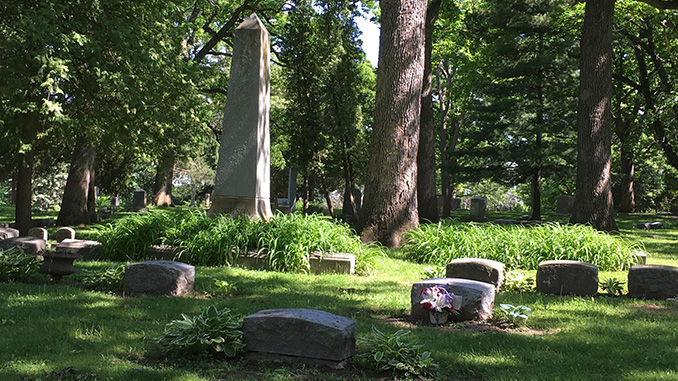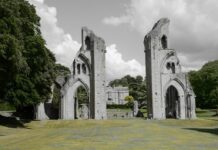
- 352shares
- Facebook339
- Twitter3
- Pinterest10
- Reddit0
- 0
- views
- Like
- Digg
- Del
- Tumblr
- VKontakte
- Buffer
- Love This
- Odnoklassniki
- Meneame
- Blogger
- Amazon
- Yahoo Mail
- Gmail
- AOL
- Newsvine
- HackerNews
- Evernote
- MySpace
- Mail.ru
- Viadeo
- Line
- Comments
- Yummly
- SMS
- Viber
- Telegram
- Subscribe
- Skype
- Facebook Messenger
- Kakao
- LiveJournal
- Yammer
- Edgar
- Fintel
- Mix
- Instapaper
- Copy Link
It made sense to use my travels to writing conferences as an excuse to see more graveyards. The World Horror Convention in New Orleans gave me the chance to visit John Kennedy Toole’s grave in Greenwood Cemetery. The World Horror Convention in Portland led me to Lone Fir Cemetery. When I went to WisCon last year, I took the opportunity to explore Madison’s lovely Forest Hill Cemetery.
I wanted to invite my roommates Martha and Paige to come along, but they had a seven-hour drive home ahead of them and were eager to get underway. I considered taking a cab, but the cemetery was only two and a half miles from my hotel. So I walked it.
I’d forgotten how not knowing exactly where you are going can make a distance seem longer. I felt as if I hiked forever through the Midwestern heat. Luckily, my path led me past Indie Coffee, where I could fortify myself with iced caffeine.
As soon as I turned into the green-dappled sunlight of Forest Hill, peace descended on me. There were enough people around, even in the heat of the afternoon, that I didn’t feel unsafe, but not so many that I needed to interact with them.
This was Memorial Day, so the cemetery office was closed. I was glad I’d printed out – and annotated – the walking tour map I found online.
Originally, this land had been chosen as a cemetery by European American settlers because the local natives had already used it as one. That continuity didn’t stop the cemetery fathers from dismantling some of the effigy mounds to level the lawns. Charles E. Brown, an archaeologist who headed the State Historical Society Museum, fought to preserve the surviving mounds. Now they are listed on the National Register of Historic Places.
Buried in the cemetery are eight Wisconsin state governors, a Nobel Prize winner, and many faculty members of the University of Wisconsin. Harry Steenbock, a professor of biochemistry, discovered Vitamins A, B, and D. Also buried here are a number of Madison pioneers. Ebenezer Brigham, the first permanent white settler in Dane County, died in 1861.
Among the Union soldiers buried at Forest Hill is Theodore Read, the last Union general to die in the Civil War. On April 6, 1865, he fought a saber duel with Confederate General Dearing, which delayed the retreat of Lee’s army and contributed to the surrender at Appomattox three days later. Also here rests Henry Harnden, the Brigadier General in command of the unit which captured Jefferson Davis after the war’s end. The Union Soldiers lot contains the remains of Wisconsin’s sons who died during the later battles of the Civil War. Beside them lie eight children who died after the war at the Soldiers’ Orphans Home in Madison.
Confederate soldiers captured in 1862 on Island #10 in the Mississippi River were imprisoned at Camp Randall (now a park and site of the football stadium for the University of Wisconsin). The POWs who died there were buried in a Confederate Rest plot in Forest Hill. No one cared for the graves until a widow from Louisiana named Alice Waterman came to Madison to manage a hotel. She maintained the plot at her own expense until her death in 1897. Now she is buried in the plot alongside her boys.
As I admired the cemetery, the air was absolutely alive with birdsong. I don’t know if I’ve ever heard so many birds singing at once. That made it all the more noticeable when the birds fell silent just as I came across the goose mound.
My research warned that Forest Hill was an active location for the paranormal. Haunted Madison suggests one visit during the day. I didn’t expect anything spooky to happen in the height of a hot summer afternoon, but as I stood beside that first Native American mound, cold crept over me, raising goosebumps. I caught the strongest scent of something. I wondered if it was unwashed bodies. Was someone living in the cemetery?
Glancing around, I found myself completely alone. I didn’t feel I was in any danger, but I did momentarily question the sanity of coming alone to a graveyard in a city where no one at all knew me.
Still, I grew up on a farm. I know the difference between the smell of unwashed humans and something big rotting. This was the chokingly sweet smell of decay. I coughed as I moved on, hoping for a breeze to blow the odor away. I’ve never smelled a ghost before, but I’ve seen them and heard them on differing occasions, so I don’t see why they couldn’t affect another of my senses as well.
The birds began to sing again as I followed the road on around the bend. That led me to the back of the graveyard, where I found the other surviving Effigy Mounds in the Veterans section. Between 500 and 1000 AD, local Native Americans used this high point, with its view of the lakes, as site for their burial mounds. The panther mounds are surrounded by veterans from the Spanish American and more recent wars.
It was strange to see the regulation government headstones lining up beside the sinuous mounds. I guess I’d expected a towering manmade hill like the one at Marietta, Ohio’s Mound Cemetery or the barrows on Salisbury Plain. Instead, the mounds at Forest Hill were low winding humps, raised only a couple of feet high above the surface of the ground. They were covered with lush green grass. If they hadn’t been labeled, it would have been easy to miss them.
While I generally don’t think twice about walking across a grave, I didn’t want to step on the effigy mounds as I tried to frame a photograph. I wasn’t sure what the etiquette was, but the area felt sacred. I wanted to be respectful. I took my photos and headed back toward the front of the graveyard, back toward the living.










